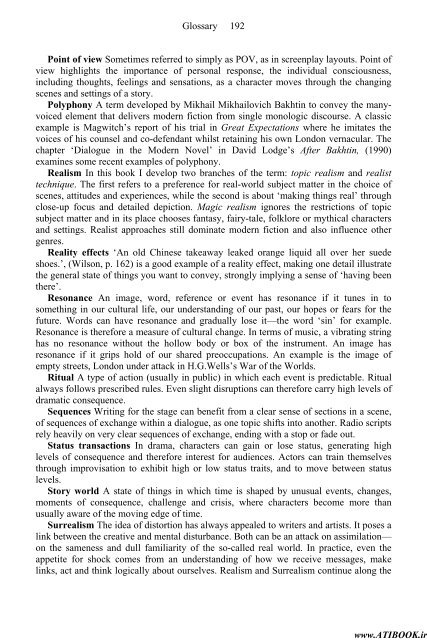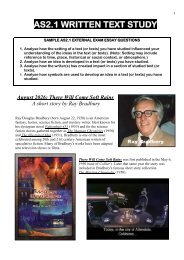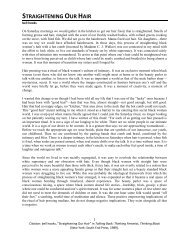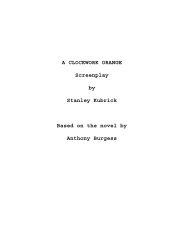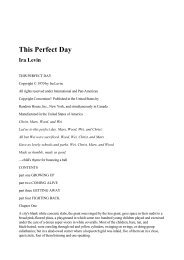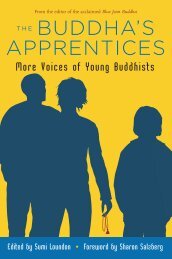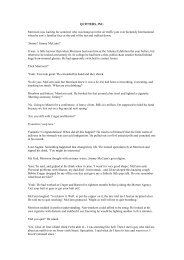9780415317856_the_routledge_creative_writing_coursebook
9780415317856_the_routledge_creative_writing_coursebook
9780415317856_the_routledge_creative_writing_coursebook
You also want an ePaper? Increase the reach of your titles
YUMPU automatically turns print PDFs into web optimized ePapers that Google loves.
www.ATIBOOK.irGlossary 192Point of view Sometimes referred to simply as POV, as in screenplay layouts. Point ofview highlights <strong>the</strong> importance of personal response, <strong>the</strong> individual consciousness,including thoughts, feelings and sensations, as a character moves through <strong>the</strong> changingscenes and settings of a story.Polyphony A term developed by Mikhail Mikhailovich Bakhtin to convey <strong>the</strong> manyvoicedelement that delivers modern fiction from single monologic discourse. A classicexample is Magwitch’s report of his trial in Great Expectations where he imitates <strong>the</strong>voices of his counsel and co-defendant whilst retaining his own London vernacular. Thechapter ‘Dialogue in <strong>the</strong> Modern Novel’ in David Lodge’s After Bakhtin, (1990)examines some recent examples of polyphony.Realism In this book I develop two branches of <strong>the</strong> term: topic realism and realisttechnique. The first refers to a preference for real-world subject matter in <strong>the</strong> choice ofscenes, attitudes and experiences, while <strong>the</strong> second is about ‘making things real’ throughclose-up focus and detailed depiction. Magic realism ignores <strong>the</strong> restrictions of topicsubject matter and in its place chooses fantasy, fairy-tale, folklore or mythical charactersand settings. Realist approaches still dominate modern fiction and also influence o<strong>the</strong>rgenres.Reality effects ‘An old Chinese takeaway leaked orange liquid all over her suedeshoes.’, (Wilson, p. 162) is a good example of a reality effect, making one detail illustrate<strong>the</strong> general state of things you want to convey, strongly implying a sense of ‘having been<strong>the</strong>re’.Resonance An image, word, reference or event has resonance if it tunes in tosomething in our cultural life, our understanding of our past, our hopes or fears for <strong>the</strong>future. Words can have resonance and gradually lose it—<strong>the</strong> word ‘sin’ for example.Resonance is <strong>the</strong>refore a measure of cultural change. In terms of music, a vibrating stringhas no resonance without <strong>the</strong> hollow body or box of <strong>the</strong> instrument. An image hasresonance if it grips hold of our shared preoccupations. An example is <strong>the</strong> image ofempty streets, London under attack in H.G.Wells’s War of <strong>the</strong> Worlds.Ritual A type of action (usually in public) in which each event is predictable. Ritualalways follows prescribed rules. Even slight disruptions can <strong>the</strong>refore carry high levels ofdramatic consequence.Sequences Writing for <strong>the</strong> stage can benefit from a clear sense of sections in a scene,of sequences of exchange within a dialogue, as one topic shifts into ano<strong>the</strong>r. Radio scriptsrely heavily on very clear sequences of exchange, ending with a stop or fade out.Status transactions In drama, characters can gain or lose status, generating highlevels of consequence and <strong>the</strong>refore interest for audiences. Actors can train <strong>the</strong>mselvesthrough improvisation to exhibit high or low status traits, and to move between statuslevels.Story world A state of things in which time is shaped by unusual events, changes,moments of consequence, challenge and crisis, where characters become more thanusually aware of <strong>the</strong> moving edge of time.Surrealism The idea of distortion has always appealed to writers and artists. It poses alink between <strong>the</strong> <strong>creative</strong> and mental disturbance. Both can be an attack on assimilation—on <strong>the</strong> sameness and dull familiarity of <strong>the</strong> so-called real world. In practice, even <strong>the</strong>appetite for shock comes from an understanding of how we receive messages, makelinks, act and think logically about ourselves. Realism and Surrealism continue along <strong>the</strong>


